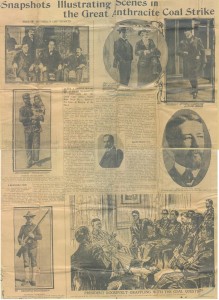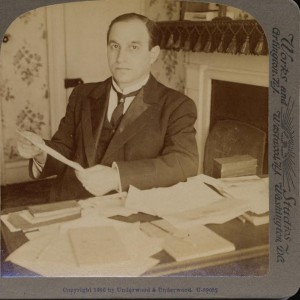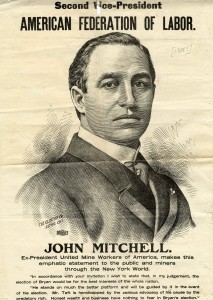
May First is a date full of meaning as ‘May Day’, a traditional European spring festival, the Feast Day of St. Joseph the Worker for Roman Catholics, and International Workers’ Day for leftists. However one marks this day it is certainly an appropriate time to note one of the most important figures in American labor history, John Mitchell, whose archival papers, including an online digital collection of his photographs, are housed at Catholic University. If Terence V. Powderly can be called ‘Labor’s American Idol,’ Mitchell was widely recognized as The Apostle of Labor after he led the fledgling United Mine Workers of America (UMWA) union through one of history’s most significant strikes, the Anthracite Coal Strike of 1902. He also wrote two books, Organized Labor (1903) and The Wage Earner (1913), arguing capital and labor could work together if both were linked in prosperity.
Mitchell was born 4 February 1870 in the coal mining village of Braidwood, Illinois, to poor Irish immigrants. Orphaned at a young age, he had little opportunity for education, and by age 12 was working in the coal mines. He joined the Knights of Labor in 1885 and in 1890 was a founding member of the United Mine Workers of America (UMWA). He became an international union organizer in 1897, working alongside the celebrated “Mother” Mary Harris Jones, before being elected UMWA Vice President that same year, and President in 1899. Union activity in this era was a risky business as coal operators controlled the mines, coal towns, and coal miners who were forced to endure horrible conditions and long hours. Miners were often paid with coupons that could only be redeemed at company stores at inflated prices and had to buy tools and supplies such as dynamite for blasting and oil for lamps. As UMWA president, Mitchell, with his priestly mien, worked to incorporate new workers from various immigrant groups, mostly Catholic, who showed their affection by nicknaming him ‘Johnnie da Mitch.’

In 1902 a strike shut down the anthracite coal fields of eastern Pennsylvania as miners demanded a pay increase, a shorter work day, and union recognition. The employers refused and tension rose as the Pennsylvania National Guard was mobilized and members of an angry public chopped up telegraph poles for firewood as needed coal became increasingly scarce and expensive. For the first time an American president, Theodore Roosevelt, intervened in a labor dispute, meeting in Washington with both Mitchell and the employers. The strike was ended and the compromise agreement resulted in a ten percent pay increase and an eight-hour work day, though the employers still refused to recognize the UMWA. However, an arbitration committee was established with equal numbers of management and labor representatives. Mitchell’s leadership was acclaimed for his moderate approach and effective organization of southern and eastern European immigrants.

During Mitchell’s time as UMWA President he worked closely with the Scottish born coal miner, William B. Wilson, who was UMWA Secretary-Treasurer before becoming a Congressman, 1907-1913, and the first Secretary of Labor, 1913-1921. Mitchell resigned as UMWA President in 1908 and then served as Chairman of the Trade Agreement Department of the National Civic Federation. He also continued to represent the UMWA at the conventions of the American Federation of Labor (AFL), an organization he also served as a Vice President, 1898-1914. In his last years, he was a member of the New York State Workman’s Compensation Commission, Federal Milk Commission, Federal Food Board for New York City, New York State Food Administration, and the New York State Council of Farms and Markets. Often in poor health, he died in New York City on 9 September, 1919, at the age of 49. He is buried in Scranton, Pennsylvania, in the Anthracite region and site of his greatest triumph, where there is also a statue of him on the grounds of the Lackawanna County Courthouse. Finally, as any of us who grew up in a coal mining household knows, every October 29 is celebrated as ‘Mitchell Day.’
